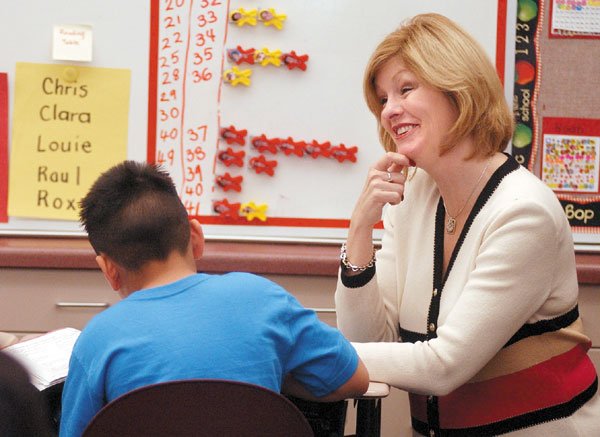Three Eliot Elementary School teachers use a variety of methods
to make math more interesting
Gilroy – Conversation Hearts – those yummy, colorful Valentine’s Day candies etched with sweet words – and math, a bevy of numbers and odd symbols. Seems like quite an odd pair.
But in Cheri Foster’s classroom the duo is as complimentary as coffee and cream. This week, each one of Foster’s second-graders received a box of the candies. Before gobbling up the product, the students guessed how many hearts were in their boxes and then they tallied up the totals.
Next, they divided them according to color and on a white piece of butcher paper, above each colored-in heart, Foster tallied up the totals. Using the candies as props for a math lesson, Foster managed to keep her students engaged and maybe even help them forget they were learning about averages, addition, subtraction and even multiplication.
And that shift away from the days of compartmentalized lessons, when arithmetic was confined to a particular lesson during a specific hour of the day, is the tool that has helped Foster, Brandy Davis and Antoinette Calip attain amazing results.
The three Eliot Elementary School teachers, who were recognized at a Gilroy Unified School District’s meeting for making such tremendous gains, are helping to close the achievement gap by continuing to move their students from the lowest rung on assessments and increase the number of students reaching the proficient or advanced levels.
Foster and Davis have worked as a team for four years. The two second grade teachers brainstorm, collaborate lessons and switch students for a portion of the day. And Calip, who teaches third grade, “just happened to show better results at this particular time.”
But ask Eliot Principal Diana Elia how Foster, Davis and Calip’s students have achieved such great gains in the classroom even though the vast majority come to Eliot as native Spanish speakers, and she’ll explain that their success is no fluke.
“They believe all of their kids can learn and they hold them all accountable,” she said.
Because more than 84 percent of their students are English language learners, if “we’re doing right by our ELL then we’re moving in the right direction.”
For Calip, a third grade teacher who has taught for 31 years, that means immersing her class in 90 minutes of math, instead of the required hour. And the longtime educator sprinkles arithmetic into everyday activities.
During PE, instead of allowing her students to simply spend their time doing jumping jacks or skipping rope, Calip tells them to count each move by threes or twos. Also, the data charts each teacher keeps that tracks every students progress throughout the year, is another major asset.
She thinks her students have shown more improvement in math because its easier for a teacher to point out where a student needs help.
“With math you can isolate their weaknesses more,” she said.
Also because their kids struggle with the English language, when they excel in math, the confidence they gain from that success often leak into reading and writing.
All three of the teachers use flash cards, games and other activities to help their students learn basic math skills. Davis and Foster award their students with team money. Each team’s coins are affixed to the wall with Velcro and the students have to add up the totals.
So, without even knowing it, they’re learning math, they said.
Up until fifth grade, all of the lessons center around “number sense,” said Davis. Many students don’t understand the bare bones of numbers and that’s probably one of the reasons their math skills suffer in the upper grades, she said.
For Foster, who has taught for 25 years, the magic pill is transparency.
“There’s a real openness of sharing and collaboration and we’re the first to ask ourselves ‘how can I turn them on? What’s going to make them click?’ ” Foster said.
One way the teachers accomplish that transparency is by drawing their students into the process. Each child creates their own crayon-colored bar graph to track their progress on the Measure of Academic Progress, an assessment administered three times a year.
That way, even if the students are scoring at below basic level, they will see the bars grow and know that when they exceed their personal best. A recurring theme, all the teachers emphasized, was that children need to be reminded that there’s only one right answer in math, but there are many ways to get there.
One of Foster’s students unknowingly demonstrated that point when he figured out that there were 58 Conversation Hearts, after multiplying two, 29 times.
Foster asked the students to pull out their calculators and walked them through the drawn-out process.
As Clara Cortez, 7, punched in the twos over and over again, she declared, “There’s an easier way.”
Foster told them to clear their calculators, punch in 29, then the X symbol and the two. And with a quick press of the equal button, the students learned that Clara was indeed right.
There is an easier way.
Eliot Elementary School Profile
Hispanic: 84 percent
Free/Reduced Lunch: 82 percent
English language learners: 74 percent
California Standards Test in Math
Second Grade
2004-2005: 49 percent
2003-2004: 33 percent
Third Grade
2004-2005: 58 percent
2003-2004: 40 percent
CST Math 2004-2005
From Second to Third Grade:
ELL: 30 percent moved to proficient or advanced.
ELL: 18 percent moved out of FBB/BB.
Third to Fourth Grade:
ELL:19 percent moved to proficient or advanced.
ELL:11 percent moved out of FBB/BB.













